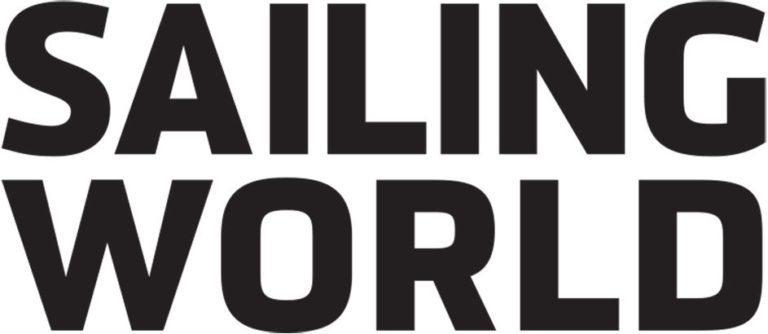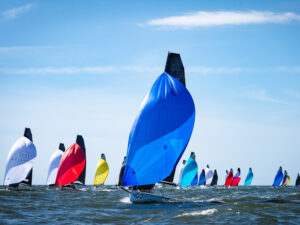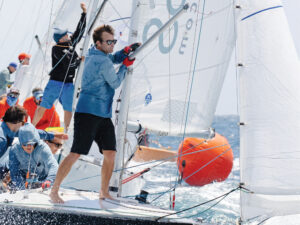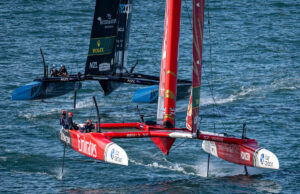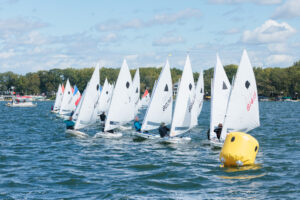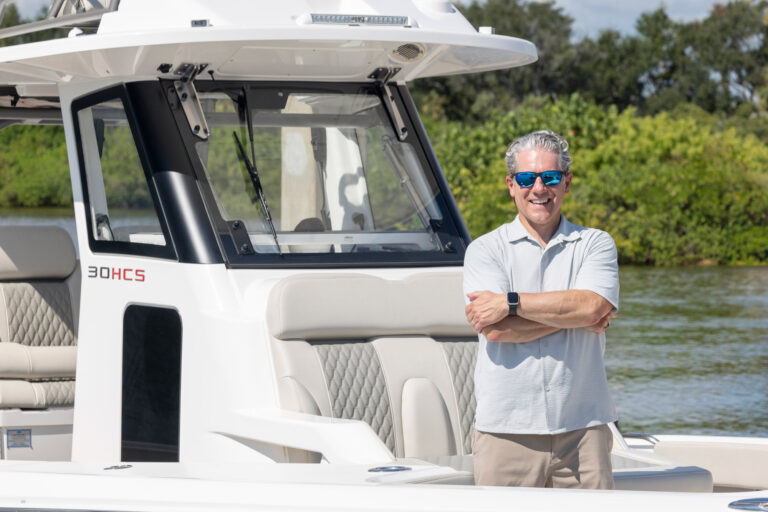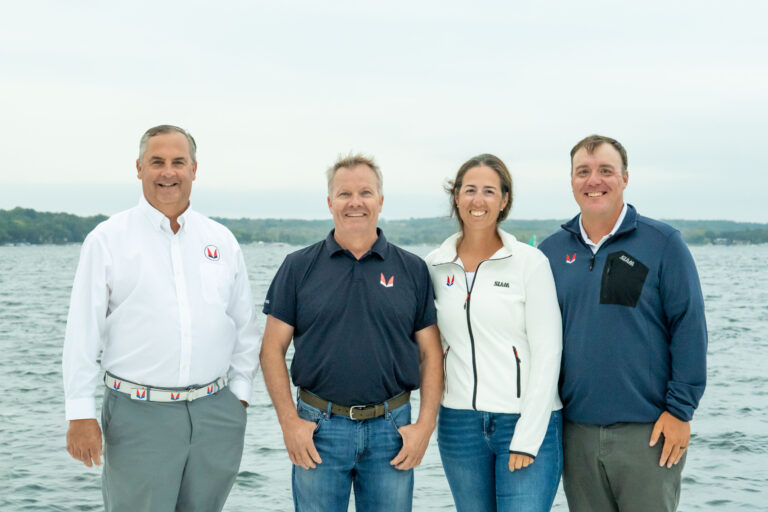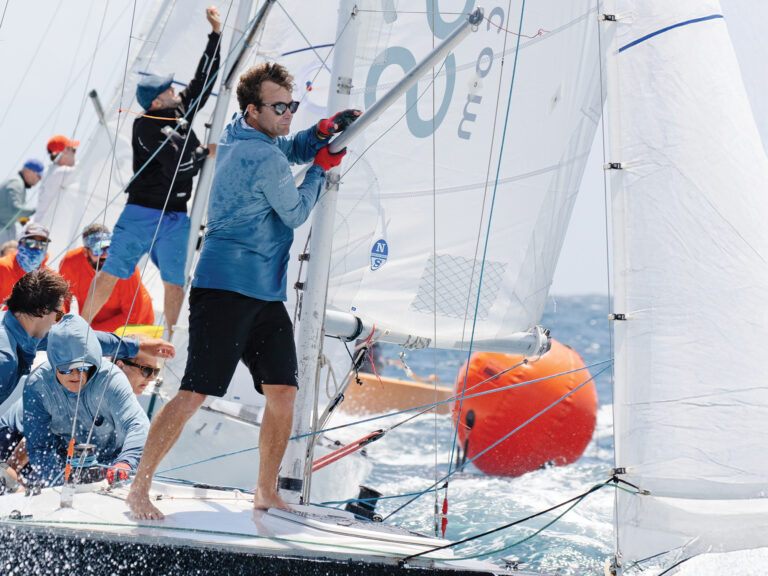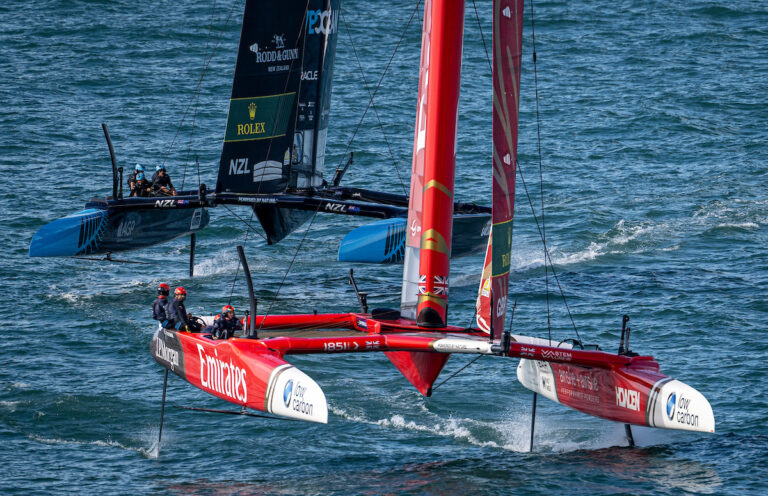
the times, they are indeed a-changin’, and that’s OK, but with sailboat racing, there’s one thing that should never, ever change: It has to be fun. No matter where we race, what we race, or how we race, the point of it all is to enjoy our time on the water, harnessing the wind and sailing to the best of our abilities. The “how we do it” is a hot topic today as clubs, classes, and regatta organizers adapt to changing demands on our free time and resources.
While participation in bigger boats is declining almost everywhere in our traditional weekend venues, there are many instances where participation is increasing or becoming more prevalent. Casual weeknight racing, for one, is a bright spot, as are pursuit races catering to newcomers and cruisers, nontraditional courses and formats, point-to-point destination races, and match and team racing using club-owned boats.
Take a look around most boatyards and marinas, and it’s easy to see that an increasing number of performance cruisers are replacing traditional or custom race boats. The challenge is to get them out of their slips and onto the racecourse, and to welcome new owners and crews into the larger racing community.
Sailors are telling us with their feet that they want something different. Formal and informal polls almost universally point to time and money constraints as the two most fundamental barriers, alongside crew recruiting, handicapping woes, and a diminishing interest in the weekend grind of windward-leeward drop-mark courses. Time is our most precious asset, especially as we see increasing mandates to return to the formal workplace, thus forcing recreational time into evenings and weekends.
Not everyone wants or needs high-level weekend races that require a practiced crew, the latest-tech sails and equipment, and a diver-smooth bottom cleaning before every race. And not everyone enjoys the stress and intimidation of a crowded starting line, especially owners who have no interest in putting their immaculately maintained family cruisers into crowded starts and roundings. Recognizing this trend, many race organizers across the country are now implementing different courses—all aimed at keeping the racing fun and the time and resource commitment lower. Here are a few that appear to be working.
Use what’s already in the water: Strict drop-mark courses require significant resources and volunteers, but using fixed navigational marks—already set—provide easy and interesting alternatives, with random legs that test the sailors with a variety of angles. They can be “closed” (start and finish at the same spot) or open, where the finish might be back at the clubhouse or perhaps a restaurant on the water that provides docking. For added interest, a course providing a “bay tour”—picking buoys near a lighthouse or other landmark—could be chosen. Try a random race, where a list of buoys and a start-finish line is posted the morning of the race. The competitors pick their own course, but every buoy must be rounded.
There are, however, a few things to keep in mind when choosing a government mark course. These buoys usually mark something—a channel, a shoal or other object to be avoided (rocks, wrecks, what have you)—so when plotting out the course, make sure it can be safely navigated. A USCG permit might be needed, so check with your local authorities, and be sure to include appropriate language in the Sailing Instructions regarding commercial traffic and traffic-control lanes.
Race from Point A to Point B (and back): These are typically “distance” or “long-course races,” usually 30 to 60 nautical miles in length to provide a reasonable day of sailing. As an incentive, host a gathering at the finish to allow sailors to swap stories, experiences, and the inevitable “if only” yarns that we all love to share. These have been very successful and are among the biggest races in the country, with hundreds of participants.
Mix up the disciplines: One approach that’s gaining popularity among younger sailors is match racing and/or team racing using club-supplied boats. In Annapolis, the 3-2-1 Regatta has introduced a new concept featuring a combination match-and-team-race format using club-supplied boats. This mixed format provides the challenge of fielding a team that is good at both match and team racing, and it proves to be fast-paced and exciting for sailors and spectators alike. It’s a great way to cross-pollinate skills for the two disciplines, and of course, even better for boathandling skill development.
Multipurpose your marks: Mixing distance race fleets into multiclass events can allow organizers to use the same starting line both for distance and buoy race fleets. Start the distance race boats first, then run windward-leeward drop-mark races off the same start-finish line. Just be sure to use the weather mark as the first and last mark for the distance racers, and remember to allow for lay days if your regatta is more than two or three days long, particularly if there are cruising classes participating. Consider activities ashore for nonracing family members and the lay day, especially in destination away venues.
Try a random race, where a list of buoys and a start-finish line is posted the morning of the race. The competitors pick their own course, but every buoy must be rounded.
Several years ago, the Performance Cruiser classes at Storm Trysail Club’s Block Island Race Week used the same start line as the windward/leeward drop-mark classes; however, once off and racing, the cruisers use the windward drop mark only as their first and last mark, and sail a navigational-buoy course around Block Island Sound. The cruising classes have grown in popularity so much that now there is a separate start line with both pursuit and fleet starts. Having only one race a day and a lay day midweek allows time for sightseeing and frolic on the island.
Embrace kites, boards and foilers: Both disciplines are becoming increasingly popular, especially among younger sailors. Formats here include reaching starts, slalom courses, and lots of fun and excitement. Many clubs are reluctant to adapt to and manage these different disciplines, but working with the competitors to ensure a safe and fun event can make for a more inclusive environment.
Experiment with a rally race: In these races, boats typically sail to a predetermined time for the race based on their handicap. They are allowed 5 minutes of engine-usage time, and the boat finishing closest to its predetermined time allowance wins. To do so, first calculate normal pursuit start times for the fixed course. Then calculate the time it will take the midfleet boat to sail the course, and add 10 percent or 20 percent to that time (use experience, US Sailing Velocity predictions or designer’s prediction to calculate the time). Start boats like a regular pursuit race. It’s great fun to see boats stalling or motorsailing flat-out at the finish to try to hit the exact time.
Try pursuit racing for low-stress starts: With pursuit racing, a boat waits until its handicap is expired before crossing the starting line, thus allowing slower boats to start first, faster boats last. This reduces or eliminates the stress of starting with many other competitors and reduces the complexity of the starting rules. It’s a very popular format with cruisers and sailors new to racing. The small boats love being in the “clear” and love to defend against the big boats chasing them down. And of course, the big boats love to pass little boats with a friendly smile and wave. The Hot Rum Series of San Diego YC uses the pursuit format over three weekends in the fall, making this annual classic one of the most popular gatherings of sailors in Southern California.
One way to make it even better is to combine a pursuit start with a destination distance race with a big party at the end. The world-famous Figawi from mainland Massachusetts to Nantucket draws hundreds of competitors to this granddaddy of fun races.
Use the starting-window scheme: This approach is being used more often in some distance races. Rather than a specific start time, boats are given a time window ranging from minutes to hours, depending on the length of the race. They pick their own time to start, but it must be within the window. Competitors have reacted favorably to this option because they can select a start time based on anticipation of current change or forecast wind changes. This is, however, more difficult to start and score because the signal boat must keep track of and record each boat’s start time to correctly calculate the elapsed time. Scoring must be done manually on a spreadsheet, but technology and GPS reporting can certainly mitigate any issues.
Le Mans is not just for cars: With this well-known format, boats are anchored behind the starting line, with all sails stowed. All crewmembers must be positioned belowdecks—or try a variant where crews are aboard, and skippers onshore must row a dinghy to the boat after the start signal. This is popular with cruisers but best for smaller fleets, and a downwind or reaching start is easier to get underway with good steerage. A long starting line is another recommendation, and you can do it for a point-to-point race if the signal boat is also participating.
Bang-and-back race is a bang: For something completely different, this one calls for all boats starting together on a reach and sailing until a cannon (or signal or VHF hail) sounds. Then it’s a tack or a jibe and a race back to the finish, wherever that might be.
Don’t forget the juniors: Youth sailors also get tired of endless drills and roll-tack practice. The UnRegatta, pioneered by the O’Pen Skiff class, mixes low-key racing with a whimsical obstacle course featuring the Bridge of Doom, which is an inflated arch that the kids must heel their boats almost 90 degrees to get through. There is nothing but smiles at the end of the day—and a bunch of enthusiastic kids who just want more.
Author’s note: This column is based on a presentation at the 2025 US Sailing Leadership Forum, with input and ideas from sailors and race-committee leaders Taran Teague, Sophie Podlich, Jeff Johnson, Nevin Sayre, Forrest Williams and Lynn Lynch.
